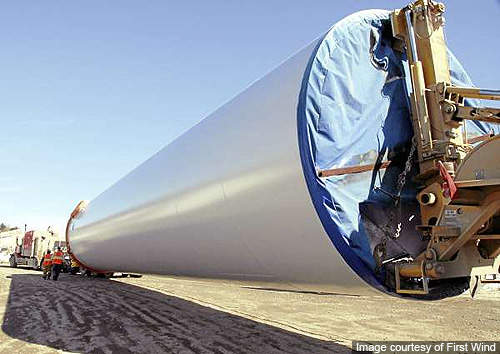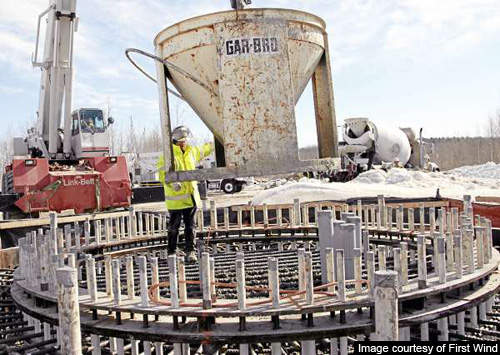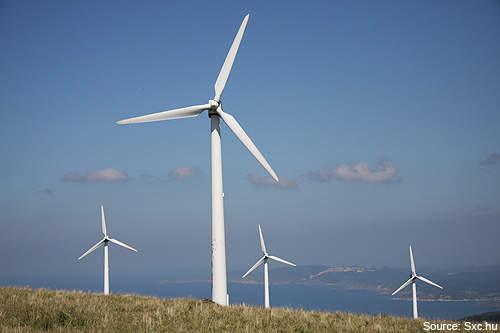The Rollins wind project is a 60MW wind energy project located in Penobscot County, Maine, about eight miles east of Lincoln. Owned by First Wind, the project will produce 168 million kWh of clean renewable energy annually to power more than 23,000 households across the towns of Lincoln, Burlington, Lee, Winn and Mattawamkeag.
Construction of the project began in September 2010 and was completed in July 2011. The $130m project will generate an estimated $24m for the tax base of four nearby communities over a 30-year period.
Clean power from the plant is being purchased by Central Maine Power (80%) and Bangor Hydro Electric (20%) as part of a 20-year contract signed in October 2009. The plant will result in avoiding approximately 80,976t of CO2 emissions annually.
Rollins wind project details
The plant consists of 40 GE 1.5MW turbines that are installed in two clusters, namely Rollins North and Rollins South. Rollins North has 18 turbines as well as the operations and maintenance building.
The remaining 22 turbines are installed in Rollins south, primarily in Lincoln and Burlington.
Each turbine measures 262ft in height to the centre of the hub and 389ft from the ground to the tip of the blade. The turbines are 125ft-long and have a 253ft rotor diameter.
To measure the wind speed and direction, four permanent 80m meteorological towers are erected onsite. During initial testing 80m meteorological towers were installed temporarily at certain turbine locations.
Construction of the plant and turbines
Despite heavy snow and high winds, work on the project progressed on schedule and within the budget. To install the turbine towers, tons of concrete were poured into steel-laced pads. Approximately 6,000 yards of concrete was used for the project.
A 440t Manitowoc main erection crane was used to top out the wind turbine generators (WTGs). About 500 contract workers were hired for the installation of the turbines.
Additional work included design and construction of roads, an electrical collector, a new substation, operation and maintenance building and other ancillary work.
Development and approval
The project won approval from the local planning board in late 2008 and state approval from the Maine Department of Environmental Protection (DEP) in April 2009.
First Wind conducted a six-year study of the site at a budget of more than $4m. The study covered all aspects from economic benefits to environmental impacts.
The project was opposed by the Friends of Lincoln Lakes for not belonging to the residential zones of Rollins Mountain but lost the case before the Maine Supreme Court. On 6 August 2009, the Board of Environmental Protection (BEP) granted a unanimous vote in favour of the DEP permit.
Grid network
Power from the plant is collected in a 5.4 mile-long 34.5kV overhead collector line between Rollins North and Rollins South for transmission to an onsite substation in Lee, Rollins North.
The substation converts the power to 115kV which is subsequently transmitted through an 8.8 mile-long 115kV transmission line-to-line 56 transmission line in Mattawamkeag. The 115kV transmission line comprises two pole H-frame structures besides triple pole structures at a few vital points.
Project finance
Project finance of $98m was secured through loans and credit facilities. An $81m non-recourse construction loan and a $17m letter of credit facility were provided by Key Bank National Association and Norddeutsche Landesbank Girozentrale. A tax equity financing agreement was signed with JPM Capital Corporation to ensure flow of long term capital to take out the construction loan.
Contractors involved in the construction project
The engineering, procurement and construction (EPC) contract for the project was awarded to Reed & Reed, a Maine-based contractor. Subcontractors included Sargent Corporation, 3-Phase Electrical, Maine Drilling & Blasting, Anderson Trucking Services, H.C. Haynes, W. T. Gardner & Sons of Lincoln and Treeline of Chester.
Power market in Maine
Maine has a population of 1.3 million people. On average, the households in Maine consume 6,348kWh of electricity annually.
The net installed electric capacity in the state stands at 4,300MW. A large share of electricity is generated from hydroelectric resources, accounting for 23% of Maine’s total electricity output.
Compared to any other US state, Maine produces substantial electricity from non-hydroelectric renewable resources. In 2010, it produced 345,000MWh of electricity from renewable sources. Wind energy represented 1.1% of the total installed electric capacity and 0.8% of the net generation in 2008.






